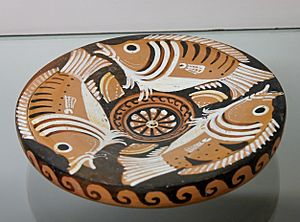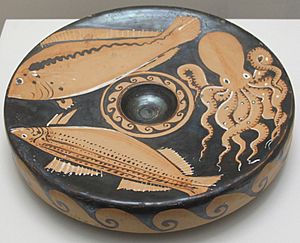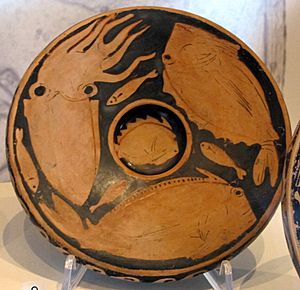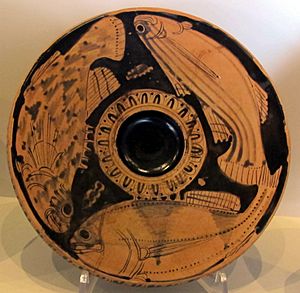Fish plate facts for kids
- This article is about a type of ancient Greek pottery. For the connection bar used in railways, see Fishplate.
A fish plate was a special kind of Greek pottery used by people in ancient Greece and Southern Italy. These plates were popular in the 300s BC. Even though they were first made in Athens, most of the fish plates we find today come from Southern Italy. Greek settlers there, called "Italiotes," made many of them.
These plates are called "fish plates" because they were often decorated with pictures of seafood. You might see different kinds of fish, like bream, perch, tuna, or even puffer fish. Other sea creatures like squid, octopus, shrimp, and crab were also common decorations.
What They Looked Like
Fish plates were usually round and flat, like a tablet. They had a small dip or cup in the middle. This cup was perfect for holding oil or sauce. The edge of the plate was often turned down and decorated. Common patterns included spiraling waves, Greek key designs, or wreaths of laurel leaves.
These plates also stood on a small base, called a pedestal foot. This lifted them slightly off the table. Plates with this shape have been around since Minoan times, long before the Greeks. However, they only started being decorated with fish in the late 400s BC.
Where They Came From
Fish plates were first made in Athens, Greece, in the late 400s BC. The fish on these early plates usually had their bellies pointing towards the outside edge of the plate. Athenian fish plates were made from red clay and painted with black shiny glaze. Sometimes, they had a little white paint on top.
Later, Greek settlers in Southern Italy started making many more colorful fish plates. They made them in cities like Taranto, Paestum, Capua, and Cumae. On these South Italian plates, the fish usually had their bellies pointing towards the sauce cup in the center.
We can tell where fish plates came from by looking at the workshops that made them.
- Attic fish plates were made in the Kerameikos area of Athens, Greece.
- Apulian fish plates came from workshops in Taranto, in the "heel" of Italy.
- Campanian fish plates were made near the Bay of Naples in Italy, in places like Capua and Cumae.
- Paestan fish plates were made in Paestum, south of Salerno, Italy. These are special because they are the only fish plates signed by the artists who made them, like Python and Asteas.
Fish plates were made in almost all Greek areas of Southern Italy, except for Lucania.
How They Were Decorated
All painted fish plates are a type of red-figure ware. This means the main parts of the creatures, like the fish, were left in the natural color of the clay. The rest of the plate was painted with a black glaze. Artists then added lighter details using thin glaze or white paint.
In the South Italian plates, artists used even more colors. They added deep red, pink, and yellow paint. This technique, which used highlights and shadows, is called "sovradipinto." Many of these fish pictures looked so real, they were like early examples of trompe-l'œil art. This style of art, which tricks the eye into thinking something is real, became very popular later in Greco-Roman paintings and mosaics found in places like Pompeii.
Some people think fish plates were decorated with the actual seafood they were meant to hold. However, many of these plates have been found in tombs. This suggests that the fish images might have been symbolic gifts for the dead. On the other hand, they could have been everyday objects that people used when alive, and were placed in tombs so the person could keep using them in the afterlife.
The plates were quite small, so they couldn't really hold some of the large sea animals shown on them. This means the decorations were more about art or symbols than showing actual food. Simple fish plates without painted decorations continued to be used throughout the Greek world for a long time.





